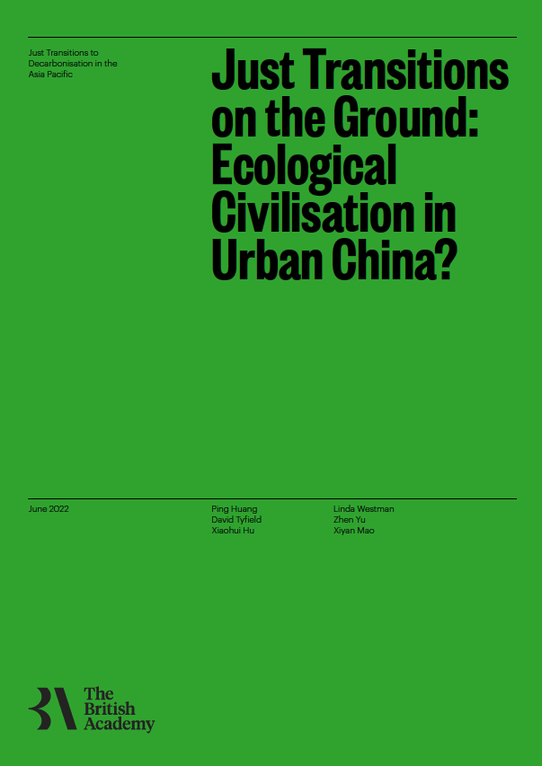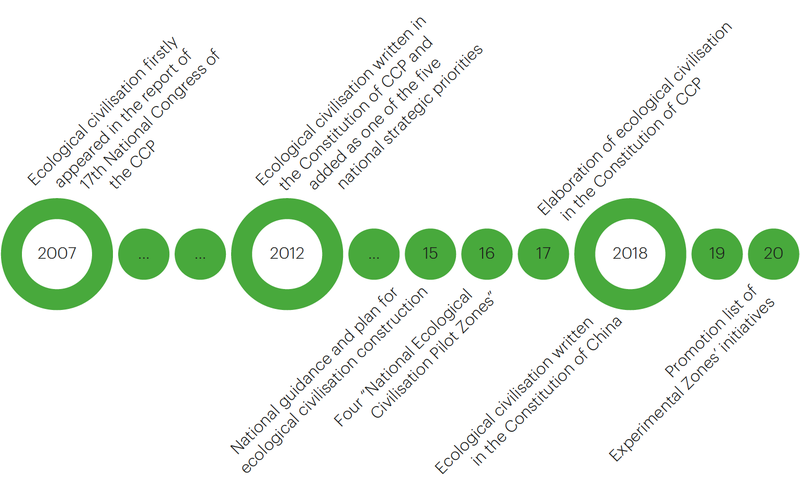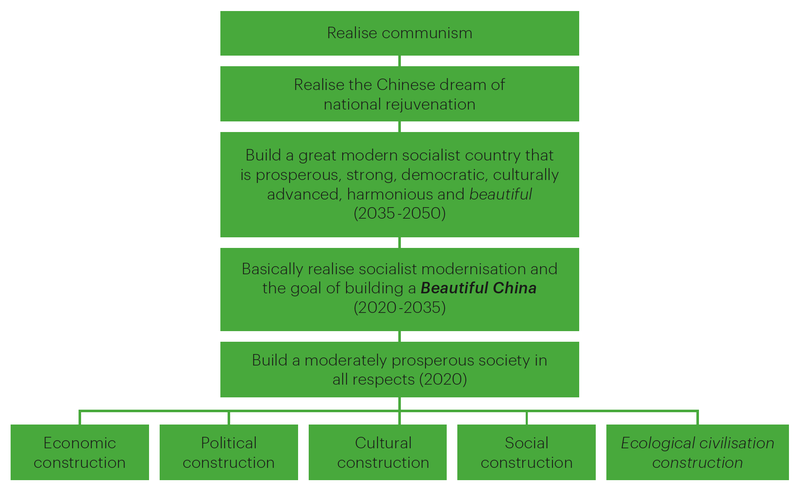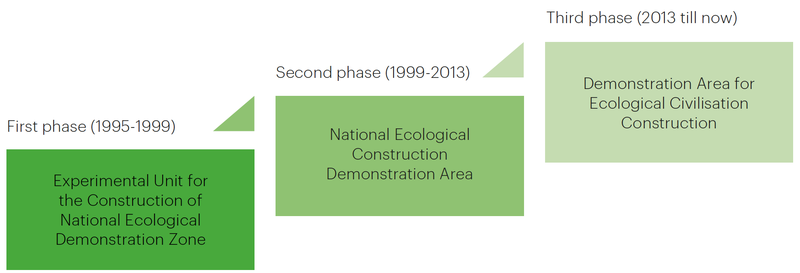Just Transitions on the Ground: Ecological Civilisation in Urban China?
Just Transitions to Decarbonisation in the Asia Pacific
by Ping Huang, David Tyfield, Xiaohui Hu, Linda Westman, Zhen Yu and Xiyan Mao
Part of

- Published by: British Academy
- Year: 2022
- Pages: 21
- DOI: doi.org/10.5871/just-transitions-a-p/P-H (Opens in a new window)
Translations
About Just Transitions to Decarbonisation in the Asia-Pacific
Working in partnership with teams from the UK Science & Innovation Network, the programme examines how just transitions whilst tackling climate change and biodiversity is key to supporting inclusive economies and societies in the future. Through the programme, the Academy awarded funding to seven research projects exploring the actions required in the Asia-Pacific to tackle climate change and biodiversity loss, to identify opportunities for decarbonising economies and societies, and to recommend options and pathways for communities, workers, businesses, policymakers and the wider public. The programme was funded by the UK’s Department for Business, Energy and Industrial Strategy.
Executive summary
The notion of “Just Transition” (JT) is gaining purchase in both academic and policy discourses related to climate change and low-carbon transitions. Despite its growing popularity, the very meanings of JT have somehow been lost in a wide spectrum of principles, aims, and visions attached to this concept. The purpose of this project is to examine the strategy of ecological civilisation (EC) in China and whether, how, and to what extent it is designed and pursued in practice as a form of JT. The core mission of this project is to reorient the attention on JT from conception to practice and rediscover its true meanings from strategic actions on the ground that aim at the actual delivery of JTs.
The project has examined the conceptualisation, institutionalisation and experimentation of EC in China. It shows that in the political discourse of China, EC is viewed as a missing component of industrial civilisation or as the ‘ecologicalisation’ of industrial civilisation, which is a more fixing view of EC. In terms of institutionalising and experimenting EC, the project shows that in China EC has already become a “political reality”, manifested in policies, institutions and nationwide practices. Regarding the understanding of JT, we observe that in China, it is a prevalent belief that social justice can only be achieved with continued socio-economic development. Therefore, EC strategy is more viewed as a means to guarantee sustainable socio-economic development, and in the course, social justice, in a broader and longer-term sense, is naturally achieved. In a word, in China, JT is largely understood as the actual delivery of a transition.
The project has conducted empirical studies in three Chinese cities of Hangzhou, Shenzhen, and Xiong’an New Area. Through in-depth interviews with key actors, we find that the perceptions and experiences of (in)justice are highly sensitive to both scale and time. In EC practices on the ground, multilevel Chinese governments adopt a quite pragmatic view of and approach to the transition, in which social learning of policymakers and diverse stakeholders is crucial for the actual delivery of a transition in a way as just as possible.
1.0 Summary of key findings and policy recommendations
Key findings
- China adopts a more fixing view of EC, namely the ‘ecologicalisation’ of industrial civilisation.
- EC has become a “political reality” in China, manifested in policies, institutions and nationwide practices.
- In China, the actual delivery of a transition to guarantee sustainable socio- economic development is the greatest justice.
- In a transition, the perceptions and experiences of social justice are sensitive to both scale and time.
- Social learning – by policymakers and diverse stakeholders – is integral to the dynamic process of just transitions.
Policy recommendations
- Institutional construction under systemic thinking.
- Incremental adaption: Long-term planning with strategic flexibility.
- Vertical integration: Combining top-level design and local-level policy experimentation.
- Horizontal coordination: Unifying fragmented responsibilities of government departments.
- Acknowledge the sensitivity of justice to both scale and time in a transition.
- Social learning is both crucial and necessary for promoting justice in a transition.
2.0 Background, project rationale, and objectives
Background
Climate crisis and the challenge of “net-zero”: A transition to net-zero GHG emissions means achieving a balance, over a specified period, between anthropogenic GHG emissions produced by human activities and those removed from the atmosphere through reduction measures. (1) Net-zero decarbonisation requires policymakers to make important social and economic decisions and to design country-specific strategies that take into account each country’s specific social, cultural, and economic needs and conditions. (2)
The quest for justice in low-carbon transitions: In international climate politics, social justice is gaining an increasingly prominent position, along with the unfolding of the JT narrative (3). The fundamental assumption is that radical and structural transformations will inevitably reinforce old and possibly induce new social inequalities. (4) This has no doubt created new challenges for international climate governance.
China’s increasing significance in international climate governance: China is a (if not, the) key player in the global transition towards decarbonisation. (5) What is happening in China is hence globally relevant. The agenda of decarbonisation is pursued in China under the EC narrative. EC is the most significant transition strategy in contemporary China, which might shape China’s decarbonisation actions in the coming decades.
Project rationale
Since its inception, the notion of JT has quickly gained attention from an array of global stakeholders. It has captured policy imaginations to become a buzzword, cutting across different sectors and encompassing a wide spectrum of principles, aims, and visions. Used unreflectively, JT often presumes currently-dominant preconceptions of justice that reflect Eurocentric ideologies. (6) Nevertheless, countries differ markedly in size, natural endowment, stage of development, and socio-political structures. Abstract, universal and rights-based notions of justice are inadequate to address intangible, institutionally engrained economic and social injustices. (7) We argue that there is no ‘one size fits all’ scenario for a just decarbonisation transition, and more nuanced approaches for JT are needed to take into account intangible factors such as culture, historical traditions, and individual subjectivities. It is time to turn our attention from theory to concrete actions in diverse contexts.
Research on JT needs to refocus on being practice driven, with a focus on examples of JT that foreground issues of strategic action and delivery.
China’s low-carbon transition and its national agenda of EC construction offer an ideal arena for the exploration of JT on the ground. Regarding JT, it may strike many readers as counter-intuitive, if not implausible, to imagine that contemporary China offers important lessons. While China is an authoritarian state currently undergoing a recentralisation and tightening of authoritarian power not seen since the rule of Mao, the characterisation of China’s political system is still most accurately depicted as ‘fragmented authoritarianism’. This has enabled meaningful, but less visible, engagement and empowerment, particularly at the city and community levels. Accordingly, China emerges as an exemplar of the importance of city-level analysis regarding JT.
Written into the national constitution in 2018, EC is integrated into China’s national agenda of socialist modernisation, with clear parallels – but also interesting differences to – JT. The term captures both a top-down project of the Chinese party-state, and, increasingly, a bottom-up project led by diverse stakeholders ‘on the ground’, who are mobilising the slogan through various environmental projects. The actual commingling and unfolding of these top-down and bottom-up interventions of EC is an empirical matter, demanding on-site and ongoing research, particularly in highly dynamic urban areas.
Project objectives
The aim of this project is to examine the strategy of EC in urban China and whether, how, and to what extent it is designed and pursued in practice as a form of JT. The specific objectives are as follows:
- Objective 1: To examine the interpretation of JT in (specific, high-profile) Chinese cities and how, whether and which JT principles are integrated into the formal strategies of EC.
- Objective 2: To explore ‘on the ground’ practices of urban innovation in China, under EC, and whether and how a new model of green and digital urbanisation is (or is not) taking shape in Chinese cities as a singular example of JT.
3.0 China's new national agenda: building ecological civilisation
The political framing of ecological civilisation
In October 2007, EC, as a term, first appeared in the report of the 17th National Congress delivered by the then president of China Hu Jintao. Following Hu’s endorsement of EC, in December 2007, the former director of China’s State Environmental Protection Agency Zhou Shenxian published a signed article on EC in the People’s Daily. (8) Ever since, EC has been assigned an increasingly prominent and important role in China’s national agenda (Figure 1). (9)
In 2012, the “Five-Sphere Integrated Plan” was put forward as a national agenda in the report of the 18th National Congress, adding “EC construction” to the previous “Four-Sphere Integrated Plan” (economic construction, political construction, cultural construction, and social construction) (Figure 2). Meanwhile, the 18th National Congress adopted the revised Constitution of the Communist Party of China and “build a socialist EC” was added in the Party Constitution. The 19th National Congress held in 2017 further consolidated the national strategy of building EC. The meeting amended and adopted the Party Constitution to add such contents as “enhancing the awareness that lucid waters and lush mountains are invaluable assets” (the well-known “Two Mountains Theory” proposed by Xi). The amended Party Constitution also enriched the 2050 national goal by adding “beautiful” to the original text of “build a great modern socialist country that is prosperous, strong, democratic, culturally advanced, and harmonious” (Figure 2). In March 2018, EC was written into the Constitution of China. In November 2020, the central government released the “National EC Experimental Zone Experience Promotion List”, which included 90 replicable and promotable reform initiatives and experiences for EC construction.
On July 1st, 2021, at the ceremony marking the centenary of the founding of the CPC, two important concepts were mentioned for the first time by the Chinese leader Xi Jinping: “the Chinese Path to Modernisation” (zhongguoshi xiandaihua) and “a new model for human advancement” (renlei wenming xingtai). It is in the interpretation of these two concepts that EC is finally assigned a clear position in China’s national agenda. According to Xi’s speech, ‘socialist EC’ represents an integral component of a new model for human advancement. (10) Nevertheless, the connotations of this “new model for human advancement” have not been specified.
Policy experimentation of ecological civilisation
In China’s EC practices at the local level, the main approach applied is policy experimentation, particularly through the designation of experimental units and pilot/demonstration zones.
The demonstration work of ecological construction in China has experienced three phases of development, with the evolution of the national ecological title from the “Experimental Unit for the Construction of National Ecological Demonstration Zone” to the “National Ecological Construction Demonstration Area” and eventually to the “Demonstration Area for EC Construction” (11) (Figure 3). Different phases in ecological demonstration work have had a different focus, which is in line with the broader social and economic circumstances of the country.
The most recent scheme of ecological demonstration is the “EC Construction Demonstration Area,” under the supervision of the MEE. The first batch of demonstration zones was announced in 2017. By the end of 2021, a total of 498 demonstration zones have been nominated for EC construction (Table 1).
4.0 Ecological civilisation on the ground
Green transition: the loss and gain of an ecological county in Hangzhou
With the deepening of the transition, the tension between economic development and ecological conservation is likely to rise, which is well manifested in the case of Chun’an county in Hangzhou.
Chun’an, designated as a Special Ecological Functional Area in Zhejiang province, shoulders important ecological responsibilities, which has, to a great extent, restricted local economic development. From a local perspective, Chun’an has made substantial sacrifices in practicing EC; while from a regional perspective, Chun’an’s sacrifice is important, if not necessary, for the prosperity of the whole region. In Chun’an, local perceptions regarding the relationship between ecology and economy in a green transition are divided. Some regard Chun’an’s sacrifice of the local economy as unnecessary and unfair, while others hold the opinion that Chun’an’s sacrifice can lead to greater welfare beyond the county.
From a policy perspective, the difficulties Chun’an currently encounters might be the reason why it has been chosen as a Practice and Innovation Base for “Lucid waters and lush mountains are invaluable assets” in 2020. A key task of this program is to explore policy innovations to effectively transfer ecological assets into economic ones and to improve the welfare of local people. Various measures have been proposed and taken in Chun’an. The effects of these policies are yet to be determined, but the experiences of Chun’an will surely inform the transition governance in other ecological areas in China.
The green transformation of Maozhou River in Bao’an District
Shenzhen, located in the southeast of China, is a pioneering city in EC practices. Nevertheless, Shenzhen’s green transition represents a typical model of “pollute first, clean up later.” Its environmental pollution problems originated from decades
of rapid industrialisation that relied largely on polluting industries. Seen from its development trajectory, Shenzhen has entered a new stage for quality development. With the lay-out of the EC initiative nationwide, a green transition in Shenzhen
has become a ‘must-do’ task under both internal and external pressures. The treatment and green transformation of the Maozhou River is at the core of Bao’an District’s green transition and EC construction. In 2018, after more than three years
of treatment, the Bao’an section of the Maozhou River has been transformed from “the most polluted river in Guangdong Province” to “the typical example of the remarkable improvement of the water environment in Shenzhen.”
It is demonstrated in the treatment of the Maozhou River that the “pollute first, clean up later” model is labor-, technology- and capital-intensive. The success of the Maozhou River project has been guaranteed by the city’s strong financial, technological, and governing capacities. Therefore, the experiences of Shenzhen might not be directly applicable to other cities. The Maozhou River project also showed that transition, as a dynamic process, always has a temporal dimension. In the case of the Maozhou River, people who suffered at the beginning of the project (e.g., noises, inconveniences, etc.) might eventually benefit greatly from the green transformation (e.g., improved environment, rising housing prices, etc.). Therefore, the temporality of transition shapes people’s perceptions of social justice.
Building a “city of the future” in Xiong’an New Area
Xiong’an New Area is about 100 km south of Beijing. The construction of Xiong’an New Area is articulated by the central government as “crucial for the millennium to come.” Therefore, anticipation is high over the planning and construction of this new area. For the central government, the political mission assigned to Xiong’an New Area is to seek an alternative form of urbanism in the era of EC. Therefore, many new planning concepts and technologies have been applied in the planning and construction of the city, with more stringent standards. This mode of ‘high-standard construction’ is backed by strong financial support from the central government, which indicates solid political will in the implementation of this “millennium plan.”
Nevertheless, various socio-economic impacts manifested during the construction of the Xiong’an New Area. From the perspective of industry upgrading, since the green transition of the area is still at the very initial stage, there would be a significant time gap between the retreat of existing industries and the coming of new industries. Social struggles and conflicts tend to be more apparent at this stage. This is, again, a question of the balance between short-term and long-term outcomes. In the long run, even if Xiong’an fails to reach its full expectation, there would also be lessons for other cities from its try-and-error endeavors.
5.0 Project findings
China adopts a more fixing view of ecological civilisation
In academic circles, there have developed two different perceptions of EC, namely the fixing view and the surpassing view (12) (Table 2). Specifically, a fixing view considers EC as merely a missing component of industrial civilisation, or the ‘ecologicalisation’ of industrial civilisation, while a surpassing view attributes EC as a more advanced form of human civilisation, which goes beyond industrial civilisation. (13) The document analysis on the political framing of EC further sets out the emerging clarity in the official formulation of the concept – now as ‘socialist EC’ specifically. This recent development indicates that CPC is more inclined to adopt a fixing view of EC, that is, EC serves as a component for promoting socialist modernisation, understood, still, within the scope of industrial civilisation.
Ecological civilisation has become a “political reality” in China
Whereas JT remains largely a normative and aspirational policy discourse in the West, in China, EC has undeniably become a political reality in many aspects, manifested in policies, institutions, and nationwide practices. In 2012, the “Five- Sphere Integrated Plan” was put forward as a national agenda in the report of the 18th National Congress, adding “EC construction” to the previous “Four-Sphere Integrated Plan” (economic construction, political construction, cultural construction, and social construction). (14) In 2018, EC was written into the Constitution of China. This marked the shift of EC from a political concept to a legal concept. With the incorporation of EC into the constitution, the basic national system in the constitution has also expanded from the economic system, political system, cultural system, and social system to the ecological system. Policy experimentation of EC has been rolled out across the country. By the end of 2021, a total of 498 demonstration zones have been designated for EC construction.
In China, the actual delivery of a transition is the greatest justice
Positioning EC within the narrative of JTs, we show that the interpretation and understanding of justice by the Chinese government and the Chinese people differ, to a certain extent, from the meanings of JT that are currently being developed in the West. In China, it is a prevalent belief that social justice can only be achieved with continued socio-economic development. Therefore, EC strategy is more viewed as a means to guarantee sustainable socio-economic development, and in the course, social justice, in a broader and longer-term sense, is naturally achieved. To put it more explicitly, in China, (realising) transition is justice, justice is transition.
In a transition, the perceptions and experiences of social justice are sensitive to both scale and time
Three empirical cases on EC practices in urban China have offered important insights into justice issues during transitions. Here we draw attention to two important notions in the perception and interpretation of justice on the ground: scale and time.
First, the relevance of scale has been well demonstrated in both Hangzhou and Xiong’an New Area. In Hangzhou, the green transition of the ecological county Chun’an can be viewed both as a sacrifice from a local perspective and as a (valuable)
contribution from a broader regional perspective. Here, different perceptions of scale shape people’s interpretation of the transition as just or unjust. In the case of the Xiong’an New Area, the “millennium plan” per se that leads to fundamental changes and struggles is justified by the higher and broader political vision of seeking an alternative mode of urbanism for the country.
Second, the temporality of the transition process also tends to shape the perceptions and experiences of justice. For the three cases, each city represents a distinctive phase of transition. For Shenzhen, a green transition of its water system has largely been achieved; for Chun’an county in Hangzhou, the transition has entered deep water, represented by the growing tension between local (economic) development and ecological conservation; while the transition of Xiong’an New Area is still at the very initial phase when social struggles and conflicts tend to be more apparent. The key question, as reiterated in this report, is how to strike a balance between short-term and long-term outcomes.
Social learning is integral to the dynamic process of Just Transitions
Through the practices of EC construction on the ground, we can see that the Chinese government adopts a quite pragmatic view of and approach to the transition. Because transition inevitably incurs social injustices and creates winners and losers, the focus is placed upon the actual delivery of transition in a way as just as possible. As such, EC offers key insights into the processes of social learning – by policymakers and diverse stakeholders – that is key to any dynamic processes of JT. Exploring the diverse forms of experimentation taking place as EC in China suggests an important redefinition of sustainable transition per se: as not a matter of reaching a ‘green’ endpoint, but as a dynamic process, without a clear end, of social learning.
6.0 Policy recommendations
Recommendation 1
Institutional construction under systemic thinking
Ecological transition is about structural changes of the socio-technical systems. It cuts across different sectors and policy domains. Therefore, the planning and policymaking must be strategic and based on systemic thinking. This entails the construction of a coordinated system of basic institutions, such as the property rights system, the spatial planning system, the resource management system, the legislation system, and the evaluation and accountability system.
Recommendation 2
Incremental adaption: Long-term planning with strategic flexibility
To initiate a net-zero transition to address the climate crisis, it entails long-term commitments from multiple parties. For the government, it is important to ensure the consistency and coherence of transition policies. A strategy is to formulate long-term planning for the transition, while at the same time assigning substantial flexibility to policy implementation. The approach of probing and testing and an error-correcting mechanism can ensure the capacity of governance structures and processes to adapt to new situations and address new challenges. In China, the key idea of the policy experimentation is the so-called “from point to area,” in which institutional, technical, and financial incentives are first experimented in different regions, and those policy innovations that work at the local level are then evaluated and selectively integrated into national policymaking for implementation at a larger scale.
Recommendation 3
Vertical integration: Combining top-level design and local-level policy experimentation
Vertical interaction and integration within the governance system is important in terms of managing the relationship between the top-level design and local policy innovation. Dynamic vertical interactions can ensure that, on the one hand, the translation of top-level design into local contexts is not “out of shape,” and on the other hand, top-level design is formulated according to the actual local conditions. Combining top-level design and local-level policy experimentation represents a cyclic mechanism of policy innovation, evaluation, and learning within a hierarchical political system.
Recommendation 4
Horizontal coordination: Unifying fragmented responsibilities of government departments
Transition involves a very complex institutional system, covering the policy arenas of resource management, accountability mechanisms, legislation, and planning. From the perspective of transition governance, this often leads to the fragmented roles and responsibilities of government departments for managing the transition process. To improve the efficiency of transition governance, it is crucial to strengthen horizontal coordination to concentrate the scattered responsibilities of different government departments. China’s “super ministries” reform is such an institutional attempt to unify fragmented responsibilities.
Recommendation 5
Acknowledge the sensitivity of justice to both scale and time in a transition
Transition is a dynamic and long-term process, which inevitably incurs social injustices. Nevertheless, transition practices on the ground in China show that social justice can be interpreted and perceived differently from different scopes and at different moments. This indicates the sensitivity of justice to both scale and time. It is important that policymakers fully acknowledge the spatiality and temporality of justice during a transition and make strategic decisions and actions based on this acknowledgment.
Recommendation 6
Social learning is both crucial and necessary for promoting justice in a transition
Transition practices in China suggest that any transition inevitably engenders various socio-economic impacts that are often related to social justice issues. It is important that policymakers keep responsive to new situations. Social learning means to innovate and adapt transition policies in response to emerging problems and needs, and to make the transition as just as possible. This continuous and dynamic process of social learning is integral to a JT.
References
Armstrong, C. (2020). 'Decarbonisation and world poverty: a just transition for fossil fuel exporting countries?'. Political Studies, 68(3), 671-688.
Bataille, C., Waisman, H., Briand, Y., Svensson, J., Vogt-Schilb, A., Jaramillo, M., Wild, T. (2020). 'Net-zero deep decarbonization pathways in Latin America: Challenges and opportunities'. Energy Strategy Reviews, 30, 100510.
Curran, D., & Tyfield, D. (2020). 'Low-carbon transition as vehicle of new inequalities? Risk-class, the Chinese middle-class and the moral economy of misrecognition'. Theory, Culture & Society, 37(2), 131-156.
Hansen, M. H., Li, H., & Svarverud, R. (2018). 'Ecological civilization: Interpreting the Chinese past, projecting the global future'. Global Environmental Change, 53, 195-203.
Heffron, R. J., & McCauley, D. (2018). 'What is the ‘just transition’?' Geoforum, 88, 74-77.
Huang, P., & Liu, Y. (2021). Toward just energy transitions in authoritarian regimes: indirect participation and adaptive governance. Journal of Environmental Planning and Management, 64(1), 1-21.
Huang, P., Westman, L., & Castán Broto, V. (2021). 'A culture-led approach to understanding energy transitions in China: The correlative epistemology'. Transactions of the Institute of British Geographers.
Jamal, T., & Hales, R. (2016). 'Performative justice: new directions in environmental and social justice'. Geoforum, 76, 176-180.
Lu, F. (2017). 'Analysis of the concept of “Ecological Civilization” [“生态文明” 概念辨析]'. Academic Journal of Jinyang, (5), 63-70.
Lu, F. (2019). Ecological Civilization: The Transcendence of Civilization [生态文明:文明的超越]. Beijing: China Science and Technology Press.
Masson-Delmotte, V., Zhai, P., Pörtner, H.-O., Roberts, D., Skea, J., Shukla, P. R., Pidcock, R. (2018). Global warming of 1.5 C: an IPCC special report on the impacts of global warming of 1.5 C above pre-industrial levels and related global greenhouse gas emission pathways, in the context of strengthening the global response to the threat of climate change, 1(5).
McCauley, D., & Heffron, R. (2018). 'Just transition: Integrating climate, energy and environmental justice'. Energy Policy, 119, 1-7.
Miller, C. A., Iles, A., & Jones, C. F. (2013). 'The social dimensions of energy transitions'. Science as Culture, 22(2), 135-148.
Rawls, J. (1971). A theory of justice: Harvard University Press.
Citations
- Masson-Delmotte, V., Zhai, P., Pörtner, H.-O., Roberts, D., Skea, J., Shukla, P. R., Pidcock, R. (2018). 'Global warming of 1.5° C'. Global warming of 1.5° C: an IPCC special report on the impacts of global warming of 1.5° C above pre-industrial levels and related global greenhouse gas emission pathways, in the context of strengthening the global response to the threat of climate change, sustainable development, and efforts to eradicate poverty, 1(5).
- Bataille, C., Waisman, H., Briand, Y., Svensson, J., Vogt-Schilb, A., Jaramillo, M., Wild, T. (2020). 'Net-zero deep decarbonization pathways in Latin America: Challenges and opportunities'. Energy Strategy Reviews, 30, 100510.
- Heffron, R. J., & McCauley, D. (2018). 'What is the ‘just transition’?' Geoforum, 88, 74-77; McCauley, D., & Heffron, R. (2018). Just transition: Integrating climate, energy and environmental justice. Energy Policy, 119, 1-7
- Curran, D., & Tyfield, D. (2020). 'Low-carbon transition as vehicle of new inequalities? Risk-class, the Chinese middle-class and the moral economy of misrecognition'. Theory, Culture & Society, 37(2), 131-156; Huang, P., & Liu, Y. (2021). Toward just energy transitions in authoritarian regimes: indirect participation and adaptive governance. Journal of Environmental Planning and Management, 64(1), 1-21; Miller, C. A., Iles, A., & Jones, C. F. (2013). 'The social dimensions of energy transitions'. Science as Culture, 22(2), 135-148.
- Huang, P., Westman, L., & Castán Broto, V. (2021). 'A culture-led approach to understanding energy transitions in China: The correlative epistemology'. Transactions of the Institute of British Geographers.
- Rawls, J. (1971). A theory of justice. Cambridge, MA: Harvard University Press.
- Jamal, T., & Hales, R. (2016). 'Performative justice: new directions in environmental and social justice'. Geoforum, 76, 176-180.
- http://www.mee.gov.cn/gkml/sthjbgw/qt/200910/t20091023_180125.htm
- Hansen, M. H., Li, H., & Svarverud, R. (2018). 'Ecological civilization: Interpreting the Chinese past, projecting the global future'. Global Environmental Change, 53, 195-203.
- https://language.chinadaily.com.cn/a/202107/02/WS60de676ca310efa1bd65f4fe.html http://wqb.guiyang.gov.cn/xwzx/szyw/202111/t20211117_71705933.html
- https://sthjt.qinghai.gov.cn/zwgk/xxgkml/stbh_305/stwmjssfsxq_308/202108/t20210813_115268.html
- Lu, F. (2017). 'Analysis of the concept of “Ecological Civilization” [“生态文明” 概念辨析]'. Academic Journal of Jinyang, (5), 63-70; Lu, F. (2019). Ecological Civilization: The Transcendence of Civilization [生态文明:文明的超越]. Beijing: China Science and Technology Press.
- Lu, F. (2019). Ecological Civilization: The Transcendence of Civilization [生态文明:文明的超越]. Beijing: China Science and Technology Press.
- http://keywords.china.org.cn/2018-11/30/content_74226981.htm
Summary
- Published
© The authors. This is an open access publication licensed under a Creative Commons Attribution-NonCommercial- NoDerivs 4.0 Unported License
To cite this report: British Academy (2022), Just Transitions on the Ground: Ecological Civilisation in Urban China? The British Academy, London
- DOI doi.org/10.5871/just-transitions-a-p/P-H (Opens in a new window)



